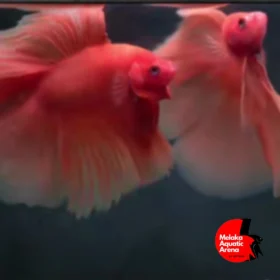Aquatic Science and Research, Aquatic Life Care, MAA Blog
5 Fascinating Reasons Why Betta Fish Flare Their Gills: The Science Behind Their Behavior
5 Fascinating Reasons Why Betta Fish Flare Their Gills: The Science Behind Their Behavior

Introduction
Betta fish, also known as Siamese fighting fish, are famous for their dazzling colors and aggressive displays. One of their most intriguing behaviors is flaring their gills, a striking display that makes them look larger and more intimidating. But why do they do this? Is it purely for defense, or does it have a deeper evolutionary significance?
In this article, we’ll dive into the science behind why betta fish flare their gills, exploring five fascinating reasons that explain this behavior. Whether you’re a betta fish owner or just curious about animal behavior, you’ll find this insight both educational and captivating.
Betta Fish Flare Their Gills to Appear Larger and Stronger
One of the primary reasons betta fish flare their gills is to create the illusion of greater size and strength. This act is especially common in male bettas, who use this display to ward off rivals and establish dominance.
According to a study published in Current Biology (source), this flaring behavior is not just for show—it serves as an honest signal of a male’s overall condition and fitness. In other words, a healthier and stronger male will have a more pronounced and prolonged flare, making it an effective way to assess opponents.
This mechanism plays a crucial role in natural selection, allowing females to choose mates based on their ability to perform these displays. In the wild, the ability to flare effectively could mean the difference between passing on genes or being outcompeted by another male.
Flaring as a Defensive Mechanism Against Threats
Another key reason betta fish flare their gills is for self-defense. In their natural habitat—shallow rice paddies and stagnant waters of Southeast Asia—betta fish often face predators like larger fish, birds, and even other bettas.
When confronted with a potential threat, a betta will flare its gills to appear bigger and more intimidating, potentially scaring off the attacker. This is a common tactic seen in many animals, from pufferfish expanding their bodies to cats arching their backs.
Even in captivity, bettas may display this behavior when they see their own reflection in the aquarium glass, mistaking it for a rival. While it might seem amusing, excessive flaring due to reflections can cause stress, so it’s best to manage their environment carefully.
Territorial Disputes and Dominance Displays
Betta fish are highly territorial, especially the males. In the wild, they establish and defend small territories where they build bubble nests and seek mates. When another male intrudes, a betta will flare its gills as a warning before resorting to physical combat.
This behavior helps reduce unnecessary fighting, as the more dominant fish is often able to scare off the weaker one without actual violence. The stronger and healthier the fish, the more impressive its flaring display, signaling to rivals that it’s not worth the fight.
This is why many betta owners notice their fish flaring when placed near another betta or when using a mirror. The reaction is instinctive, mimicking how they would behave in the wild when encountering an intruder.
Mating Rituals and Courtship Displays
Interestingly, flaring isn’t always about aggression—it can also play a role in courtship. Male bettas will often flare their gills while performing elaborate displays to attract a female. This behavior signals strength, vitality, and genetic fitness, making them more appealing to potential mates.
A healthy male with vibrant colors and a strong flare is more likely to impress a female, leading to a successful mating process. Once the female is receptive, the male will continue with his courtship dance before proceeding to build a bubble nest where the eggs will be fertilized and cared for.
Flaring Due to Stress or Overstimulation
Not all flaring is beneficial—sometimes, betta fish flare their gills due to stress or environmental factors. Triggers may include:
- Poor water conditions (high ammonia levels, sudden temperature changes)
- Overcrowding (being kept in small tanks or with incompatible tank mates)
- Frequent exposure to reflections or other aggressive fish
While occasional flaring is normal and healthy, excessive or prolonged flaring can lead to exhaustion and weakened immune function. If you notice your betta flaring excessively, it’s essential to check its tank conditions, reduce external stressors, and provide a calm environment.
FAQs
Why do betta fish flare their gills when they see their reflection?
Betta fish mistake their reflection for another betta and instinctively flare to establish dominance. If this happens too often, consider adjusting the lighting or tank placement to reduce reflections.
Can female betta fish flare their gills?
Yes, but less frequently than males. Female bettas may flare when defending territory, during hierarchy disputes, or in response to perceived threats.
Is flaring bad for betta fish?
Occasional flaring is healthy and helps exercise their muscles, but excessive flaring can lead to stress. If your betta flares too often, check for environmental stressors.
Do bettas always fight after flaring?
Not necessarily. Flaring is often a warning signal meant to deter conflict. However, if two bettas are in the same space, a fight may eventually break out.
Should I use a mirror to make my betta flare?
Using a mirror for short periods (a few minutes a day) can be a good exercise for your betta, but excessive use can cause stress.
How can I reduce my betta’s stress-induced flaring?
Ensure your betta has a properly maintained tank, a good diet, and minimal exposure to unnecessary stressors like aggressive tank mates or constant reflections.
Conclusion
Betta fish flare their gills for a variety of reasons, from establishing dominance to warding off threats and even attracting mates. While this behavior is natural and essential for their survival, excessive flaring can indicate stress or environmental issues.
As a responsible betta owner, observing and understanding this behavior can help you ensure your fish remains healthy and stress-free. By providing the right environment and minimizing unnecessary stressors, you allow your betta to thrive while displaying its natural instincts in a controlled and safe way.
For more fascinating insights into animal behavior, check out the scientific study on betta fish displays here: Current Biology.

